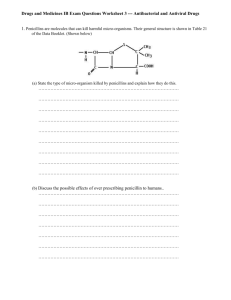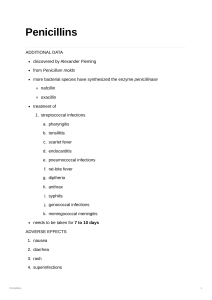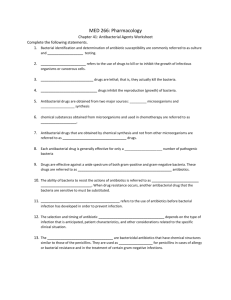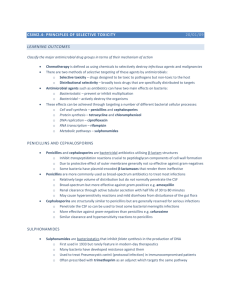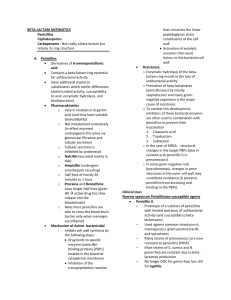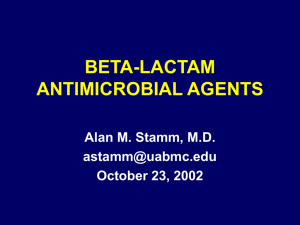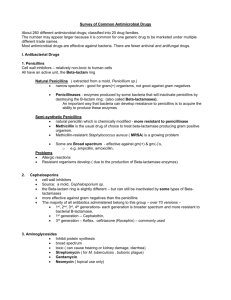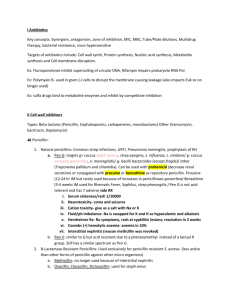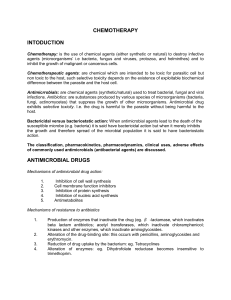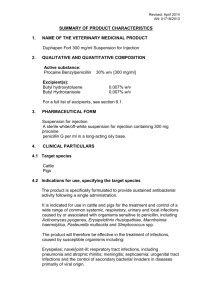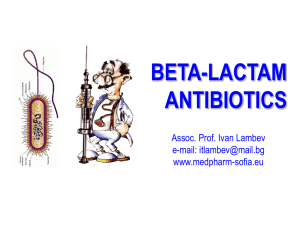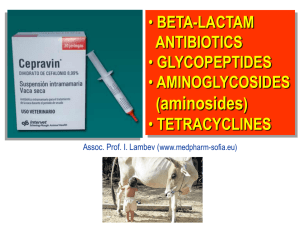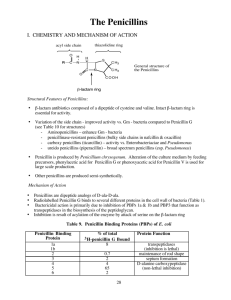Antimicrobial agents - antibiotics + synthetic chemiotherapeutics
advertisement
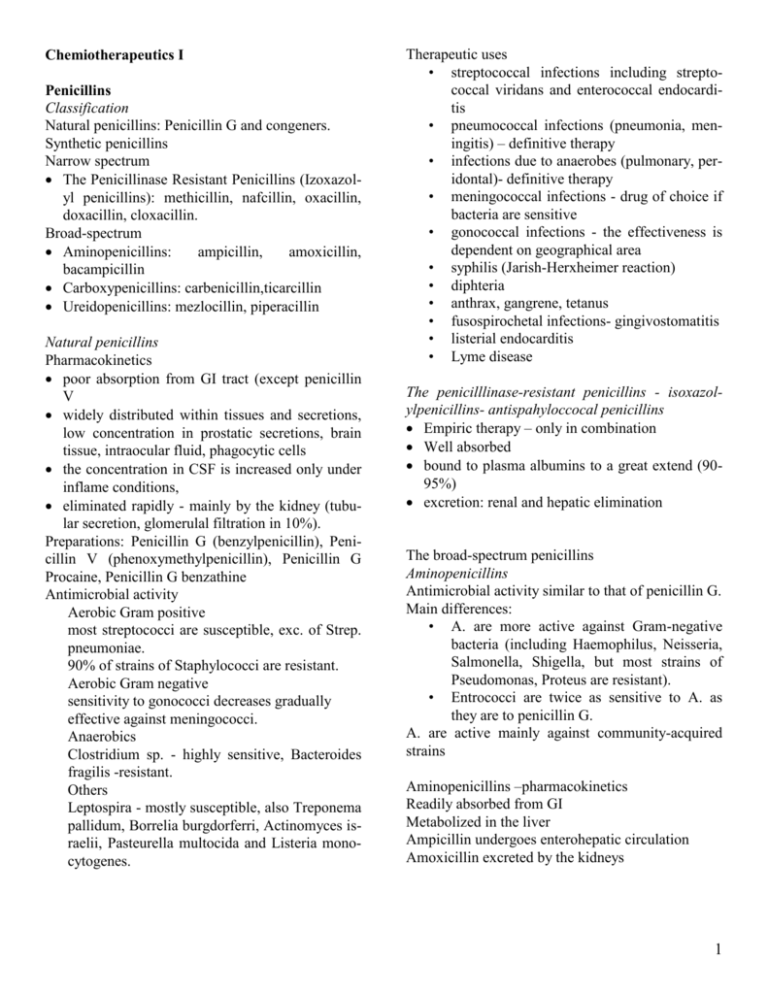
Chemiotherapeutics I Penicillins Classification Natural penicillins: Penicillin G and congeners. Synthetic penicillins Narrow spectrum The Penicillinase Resistant Penicillins (Izoxazolyl penicillins): methicillin, nafcillin, oxacillin, doxacillin, cloxacillin. Broad-spectrum Aminopenicillins: ampicillin, amoxicillin, bacampicillin Carboxypenicillins: carbenicillin,ticarcillin Ureidopenicillins: mezlocillin, piperacillin Natural penicillins Pharmacokinetics poor absorption from GI tract (except penicillin V widely distributed within tissues and secretions, low concentration in prostatic secretions, brain tissue, intraocular fluid, phagocytic cells the concentration in CSF is increased only under inflame conditions, eliminated rapidly - mainly by the kidney (tubular secretion, glomerulal filtration in 10%). Preparations: Penicillin G (benzylpenicillin), Penicillin V (phenoxymethylpenicillin), Penicillin G Procaine, Penicillin G benzathine Antimicrobial activity Aerobic Gram positive most streptococci are susceptible, exc. of Strep. pneumoniae. 90% of strains of Staphylococci are resistant. Aerobic Gram negative sensitivity to gonococci decreases gradually effective against meningococci. Anaerobics Clostridium sp. - highly sensitive, Bacteroides fragilis -resistant. Others Leptospira - mostly susceptible, also Treponema pallidum, Borrelia burgdorferri, Actinomyces israelii, Pasteurella multocida and Listeria monocytogenes. Therapeutic uses • streptococcal infections including streptococcal viridans and enterococcal endocarditis • pneumococcal infections (pneumonia, meningitis) – definitive therapy • infections due to anaerobes (pulmonary, peridontal)- definitive therapy • meningococcal infections - drug of choice if bacteria are sensitive • gonococcal infections - the effectiveness is dependent on geographical area • syphilis (Jarish-Herxheimer reaction) • diphteria • anthrax, gangrene, tetanus • fusospirochetal infections- gingivostomatitis • listerial endocarditis • Lyme disease The penicilllinase-resistant penicillins - isoxazolylpenicillins- antispahyloccocal penicillins Empiric therapy – only in combination Well absorbed bound to plasma albumins to a great extend (9095%) excretion: renal and hepatic elimination The broad-spectrum penicillins Aminopenicillins Antimicrobial activity similar to that of penicillin G. Main differences: • A. are more active against Gram-negative bacteria (including Haemophilus, Neisseria, Salmonella, Shigella, but most strains of Pseudomonas, Proteus are resistant). • Entrococci are twice as sensitive to A. as they are to penicillin G. A. are active mainly against community-acquired strains Aminopenicillins –pharmacokinetics Readily absorbed from GI Metabolized in the liver Ampicillin undergoes enterohepatic circulation Amoxicillin excreted by the kidneys 1 Therapeutic uses of aminopenicillins • respiratory infections • urinary tract infections • prevention of bacterial endocarditis • salmonella infections • meningitis - are not indicate as a single agent to avoid resistance, excellent activity against Listeria meningitidis in immunocompromised persons amoxicillin + clavulanic acid, ampicillin + sulbactam, ticarcillin + clavulanic acid, piperacillin + tazobactam Antipseudomonal penicillins Carboxypenicillins and ureidopenicillins • active against some isolates of Pseudomonas aer. and certain indole-positive Proteus sp. • ineffective against most strains of Staph., B. fragilis • ureidopenicillins - useful for treatment of infection with Klebsiella and Enterococcus faecalis • sensitive to destruction by betalactamases • mezlocillin, ticarcillin and piperacillin excreted in the bile in a significant degree, carbenicillin rapidly excreted as active moiety in the urine • therapeutic indications: serious infections caused by Gram-negative bacteria Second-generation: Cefamandole,Cefaclor , Cefuroxime axetil good activity against gram-negative bacteria modest activity against gram-positive active against Bacteroides susceptible to beta-lactamase Untoward reactions to penicillins hypersensitivity reactions bone marrow depression: granulocytopenia (aminopenicillins) hepatitis defect of hemostasis hyperkaliemia neurological effects allergic reaction to procaine pseudomembranous colitis Hoigne syndrome -lactamase inhibitors Cephalosporins First-generation: Cephalotin, Cefazolin, Cephalexin good activity against Streptococci, Staph. aureus modest activity against gram-negative susceptible to beta-lactamase Third-generation: Cefotaxime , Ceftriaxone active against gram-negative activity against gram-positive comparable to firstgeneration agents more resistant to beta-lactamases penetrate CSF Ceftazidime, Cefoperazone Especially active against Pseudomonas Moderately active against gram-positive bacteria Fourth-generation: Cefepime Spectrum comparable to third-generation but more resistant to beta lactamases Better penetrate CSF. Pharmacokinetics • Well absorbed (depends on agent) • Partially metabolized in the liver • Excreted primarily by the kidneys (except cefoperazone) • Penetrate CSF Poor antimicrobial activity, bind beta-lactamases and inhibit them Active against plasmid-coded beta-lactamases, resistant to the chromosomal beta-lactamases induced by gram-negative bacilli Used in combination with beta-lactams to achieve wider spectrum of activity 2 Therapeutic uses of cephalosporins • pneumonia (Pneumococci, Haemophilus, Staphylococci) • serious infections caused by Gram negative aerobic bacteria • cefotaxime and ceftriaxone - drugs of choice for the initial therapy of meningitis in nonimmunocompromised adults • ceftazidime + aminoglycoside - treatment of choice for Pseudomonas meningitidis • ceftriaxone - drug of choice for all forms of gonorrhoea • typhoid fever - cefoperazone, ceftriaxone Pharmacokinetics: good tissue distribution incl. CSF, excreted mostly unaltered in the urine. Adverse reactions: • hypersensitivity reaction • diarrhea • granulocytopenia • nephrotoxicity??? • • • cross-reactivity with penicillins intolerance of alcohol bleeding Carbapenems (imipenem, meropenem) Gram-positive aerobics: Streptococci, Enterococci, Staphylococci Gram-negative aerobics: Enterobacteriacae, most strains of Pseudomonas Anaerobes Highly resistant to beta-lactamases Treatment of nosocomial infections Adverse effects: nausea, seizures, hypersensitivity Pharmacokinetics: penetration CSF variable, excreted by the kidneys mainly as unchanged substance.Imipenem is hydrolyzed rapidly by dipeptidase. Monobactams (aztreonam) Gram-negative aerobics, especially: Pseudomonas, Hemophilus, Gonococci Resistant to most of the beta-lactamases Therapeutic use: in selected instances (drug of the last choice) - in place of aminoglycosides Adverse reaction: generally well tolerated – allergy. No cross-reactions to other beta-lactams 3
